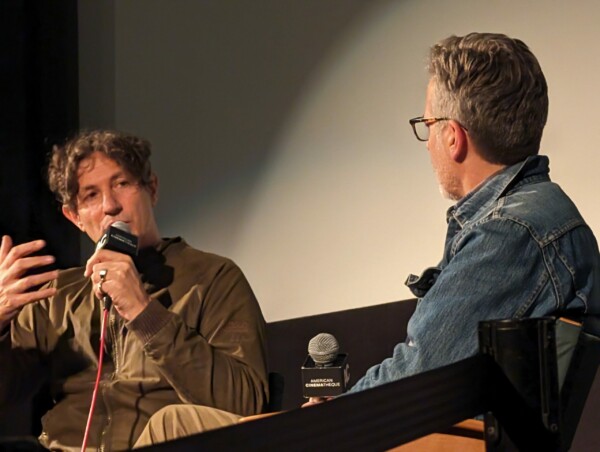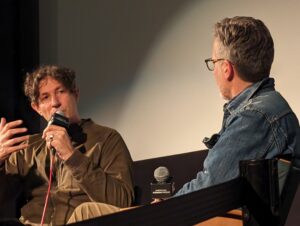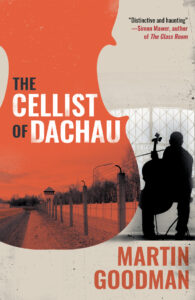The Zone of Interest – Martin Goodman reflects
December 8, 2023

Martin Goodman ponders questions posed by the decisions taken in filming The Zone of Interest, compared to those he faced when writing his own related The Cellist of Dachau. Both go inside the homes of Nazi families, who live beside concentration camps. One chooses not to portray the horrors…
Visiting Auschwitz, it’s striking to see the family home of the camp Kommandant Rudolf Höss tucked against the concentration camp’s walls.
Joanathan Glazer’s new film The Zone of Interest takes you inside the walls and gardens of that recreated home. It’s a slow and steady visit, the film opening with minutes of black screen while a soundtrack of dark echoes plays against it.
The first scene is a summer pastoral, the Höss family picnicking by a river. We then follow them home. This is a fine home, a garden of flowers and vegetables lovingly tended by Frau Höss, the “Queen of Auschwitz”. It’s a good place to bring up the family, away from the stresses of the city. The horrors of Auschwitz are kept off-screen, only to be heard on the soundtrack. Distant chimneys belch smoke. Businessmen bring plans for a new construction: crematoria where the heating of furnaces in one chamber cools another, enough that human ashes can be processed.

Jonathan Glazer speaking with Jonathan Lethem
The film was presented pre-release at the Aero Cinema in Santa Monica, stoking any Oscar interest among Los Angeles’ voters. Jonathan Glazer appeared in conversation with the novelist Joanathan Lethem – who first asked the director to speak of the film’s studied dullness.
There is no story, Glazer said, no drama (though there is the drama of whether the Höss family will be forced from their much-loved home). It was a film he didn’t want to make, and the cast didn’t want to appear in. His intention was to have the audience project themselves onto the ordinariness of the Höss family, and understand the simple human lives behind the mass extermination of whole peoples.
Glazer had ten hidden cameras working, but no film crew on set – scenes were relayed by cable to a distant container. He used no cinematic lighting – it was all daylight or the light from the house’s regular lamps. The Höss house was recreated for the film.
The film, in this way, was a product of the director’s sensibilities, his worry about turning cameras directly on the horrors. As scripted, Frau Höss set out ladies’ clothes for the staff to select from and chose a fur coat for herself. The audience was left to work out that these were the clothes of Jews sent to the gas chambers; that the Höss children played with gold teeth taken from murdered Jews. In conversation with friends Frau Höss joked that someone had thought her coat came from Canada the country. The Canada joke was not explained. What is the explanation? That “Canada” was the name given to the warehouses in which goods stolen from Jews about to be murdered were stored. It was a name for the inmates to use, “Canada” standing in for all that was wonderful if you could escape from the camp. I learned that “Canada” detail on a weeklong visit to Auschwitz. How many have done that? The film asks its audience to fill in the details of the Holocaust from their own knowledge.
How many have that knowledge?
In an early draft of my novel The Cellist of Dachau I too omitted details of what went on in the camps, and tried to avoid mentioning Auschwitz. There was a wish not to add to the horrors by dramatizing them. Then I realized that people no longer know those details. And even all that I knew was almost nothing when set aside what went on, when I looked more closely. So I told what happened at Dachau, at Buchenwald, at Theresienstadt, and at Auschwitz.
not to add to the horrors by dramatizing them. Then I realized that people no longer know those details. And even all that I knew was almost nothing when set aside what went on, when I looked more closely. So I told what happened at Dachau, at Buchenwald, at Theresienstadt, and at Auschwitz.
A link between novel and film is that I also focused on a Nazi family – in this case the Adjutant at Dachau and his pregnant wife. I spent time inside the camp at Dachau, but also examined the quarters outside, picking a home for the Adjutant. The fusion of human elements with Nazi monstrosity fueled The Cellist of Dachau which sought some response to the question “How can the Nazis have loved the music of J.S.Bach and Schubert while committing genocide?”
Another curious link – both the novel and film included the present site’s women cleaners. In the film, they are cleaning the display cases in which items such as mounds of shoes stolen from Jews, their luggage, their walking aids, are on show. In my novel I used a scene that struck me on my visit: men with machines cutting plants in the forest, while women in electric carts dusted information signs. There’s some link between men and the mechanization of slaughter.
The Zone of Interest is a worthy and honest film, doing its best to express “the banality of evil”. But it needn’t set a trend, for not many of us have the details to fill in what we hear on the soundtrack. The film is set in 1943. It’s recent, yet pre-history for some of today’s young. We can’t presume its horrors are known, or that any lessons have been learned.
We then follow them home. This is a fine home, a garden of flowers and vegetables lovingly tended by Frau Höss, the “Queen of Auschwitz”. It’s a good place to bring up the family, away from the stresses of the city. The horrors of Auschwitz are kept off-screen, only to be heard on the soundtrack. Distant chimneys belch smoke. Businessmen bring plans for a new construction: crematoria where the heating of furnaces in one chamber cools another, enough that human ashes can be processed.
The film was presented pre-release at the Aero Cinema in Santa Monica, stoking any Oscar interest among Los Angeles’ voters. Jonathan Glazer appeared in conversation with the novelist Joanathan Lethem – who first asked the director to speak of the film’s studied dullness.
There is no story, Glazer said, no drama (though there is the drama of whether the Höss family will be forced from their much-loved home). It was a film he didn’t want to make, and the cast didn’t want to appear in. His intention was to have the audience project themselves onto the ordinariness of the Höss family, and understand the simple human lives behind the mass extermination of whole peoples.
Glazer had ten hidden cameras working, but no film crew on set – scenes were relayed by cable to a distant container. He used no cinematic lighting – it was all daylight or the light from the house’s regular lamps. The Höss house was recreated for the film.
The film, in this way, was a product of the director’s sensibilities, his worry about turning cameras directly on the horrors. As scripted, Frau Höss set out ladies’ clothes for the staff to select from and chose a fur coat for herself. The audience was left to work out that these were the clothes of Jews sent to the gas chambers; that the Höss children played with gold teeth taken from murdered Jews. In conversation with friends Frau Höss joked that someone had thought her coat came from Canada the country. The Canada joke was not explained. What is the explanation? That “Canada” was the name given to the warehouses in which goods stolen from Jews about to be murdered were stored. It was a name for the inmates to use, “Canada” standing in for all that was wonderful if you could escape from the camp. I learned that “Canada” detail on a weeklong visit to Auschwitz. How many have done that? The film asks its audience to fill in the details of the Holocaust from their own knowledge.
How many have that knowledge?
In an early draft of my novel The Cellist of Dachau I too omitted details of what went on in the camps, and tried to avoid mentioning Auschwitz. There was a wish not to add to the horrors by dramatizing them. Then I realized that people no longer know those details. And even all that I knew was almost nothing when set aside what went on, when I looked more closely. So I told what happened at Dachau, at Buchenwald, at Theresienstadt, and at Auschwitz.
A link between novel and film is that I also focused on a Nazi family – in this case the Adjutant at Dachau and his pregnant wife. I spent time inside the camp at Dachau, but also examined the quarters outside, picking a home for the Adjutant. The fusion of human elements with Nazi monstrosity fueled The Cellist of Dachau which sought some response to the question “How can the Nazis have loved the music of J.S.Bach and Schubert while committing genocide?”
Another curious link – both the novel and film included the present site’s women cleaners. In the film, they are cleaning the display cases in which items such as mounds of shoes stolen from Jews, their luggage, their walking aids, are on show. In my novel I used a scene that struck me on my visit: men with machines cutting plants in the forest, while women in electric carts dusted information signs. There’s some link between men and the mechanization of slaughter.
The Zone of Interest is a worthy and honest film, doing its best to express “the banality of evil”. But it needn’t set a trend, for not many of us have the details to fill in what we hear on the soundtrack. The film is set in 1943. It’s recent, yet pre-history for some of today’s young. We can’t presume its horrors are known, or that any lessons have been learned.



